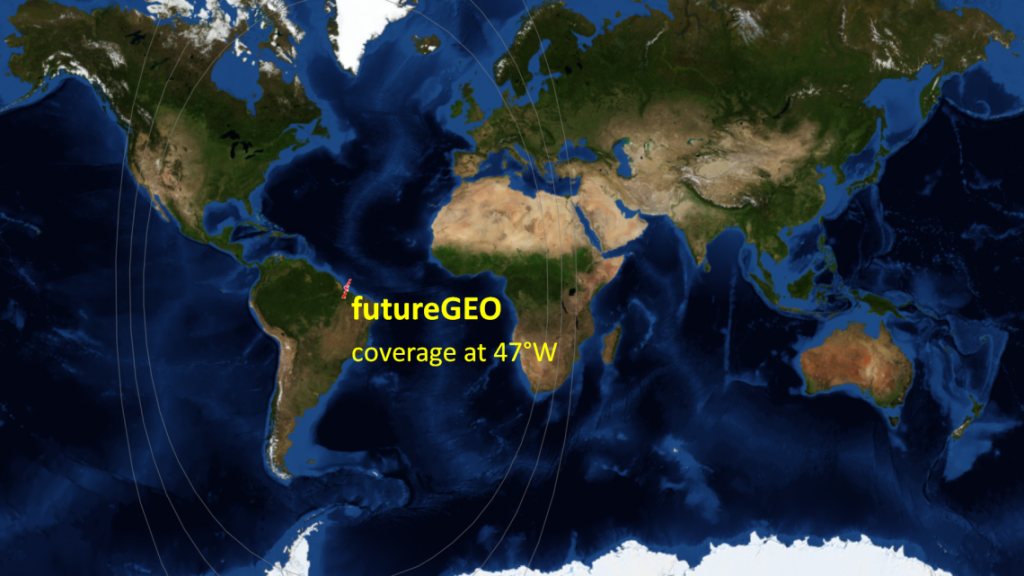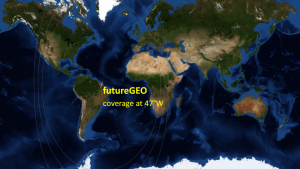By Cale Mooth K4HCK
You might not know it, but plans are currently in progress to launch a geostationary amateur radio satellite that would provide multi-mode communications coverage to Europe and most of North America. Led by ESA and AMSAT, the project is currently called futureGEO and would be the pinnacle of achievement for the amateur radio hobby.
futureGEO is likely to be very similar to the QO-100 satellite that covers Europe, Africa, the Middle East, and a large portion of Asia. The major difference of course would be the inclusion of North America within FutureGEO’s footprint, opening up geostationary satellite ops to one of the largest ham radio populations in the world.
What makes futureGEO so compelling is the showcase of modern radio and software technology, as well as the relatively low barrier to entry to satellite communication. Like QO-100, futureGEO may feature analog and digital transponders as well as a fully integrated software defined radio stack. What that opens up is every existing ham radio mode, analog and digital, utilized through an easily accessible stationary satellite.
Beyond typical ham radio activities, QO-100 supports high-definition video nets through the use of amateur digital television. Wideband digital transponders open up the possibility of great experimentation from hams with a strong technical and especially software focused background. Imagine receiving amateur radio television with similar ease to that of DirecTV or Starlink.
Access to this technology is achievable. Everything required to access futureGEO from your own backyard can be possible for about the same cost as an entry level HF rig. Cheaper for those willing to build their own components. Very obtainable by the vast majority of hams. This is a technical achievement that would be out of reach for most hams just a couple decades ago due to cost.
Redefining the perception of amateur radio
Read just about any mainstream news article about amateur radio and it’s inevitably framed as an old technology that’s kept alive by a dedicated few. Maybe satellite based video conferencing or high-speed data transfers without the use of the internet begins to change that old narrative.
futureGEO also opens up entirely new educational outreach opportunities. Think ARISS but focused on satellite communications instead of the ISS.
Based on current progress and the pace at which QO-100 was implemented, we could see futureGEO become reality within the next 4-5 years.
So why is no one talking about this project?
Why are most of the major ham radio organizations in North America absent from the conversation? Based on a presentation from ESA in 2023, the futureGEO concept was sparked by the IARU and supported by ESA, AMSAT-UK, and AMSAT-DL. For a proposed footprint that could cover most of North America, North American entities have largely been quiet. The exception being the formation of AMSAT-CA (Canada). (But even their website features only two sentences related to futureGEO and has yet to make public the referenced paper.)
AMSAT-NA has relayed updates from AMSAT-DL and contributed to a proposal in 2023, but very little promotion has been published to their website. Earlier this year I asked about futureGEO updates at the AMSAT booth at both Hamvention and Huntsville but they weren’t able to relay even basic talking points. IARU is credited with starting the conversation, but there’s no mention of the project on their website.
Personally, I find this the most exciting active development in ham radio. To show my support I’ve become a member of AMSAT-UK and will continue to promote this project through both Amateur Radio Daily and Amateur Radio Weekly. If this project interests you, I’d highly encourage you to find a way to help promote it. Present about it at an upcoming club meeting. Mention it on the air on the local repeater. Post to your favorite Facebook Group. It’s up to us.
futureGEO Resources
- 2023 ESA futureGEO presentation
- 2023 AMSAT-UK & BATC payload proposal (PDF)
- 2024 ESA futureGEO presentation at FOSDEM
- 2024 AMSAT-DL payload proposal (PDF)
- AMSAT-DL futureGEO GitLab space
- AMSAT-DL futureGEO forum
- futureGEO Workshop Memo from ORI
Source: Amateur Radio Daily
Amateur Radio Daily – Read More










More Stories
via Hackaday: Internet Archive Hits One Trillion Web Pages
via the ARRL: ARRL VEC Ready to File 2,500+ Ham Radio License Applications; FCC Extends Renewal Filing Deadline
via the ARRL: SKYWARN Recognition Day 2025 Cancelled